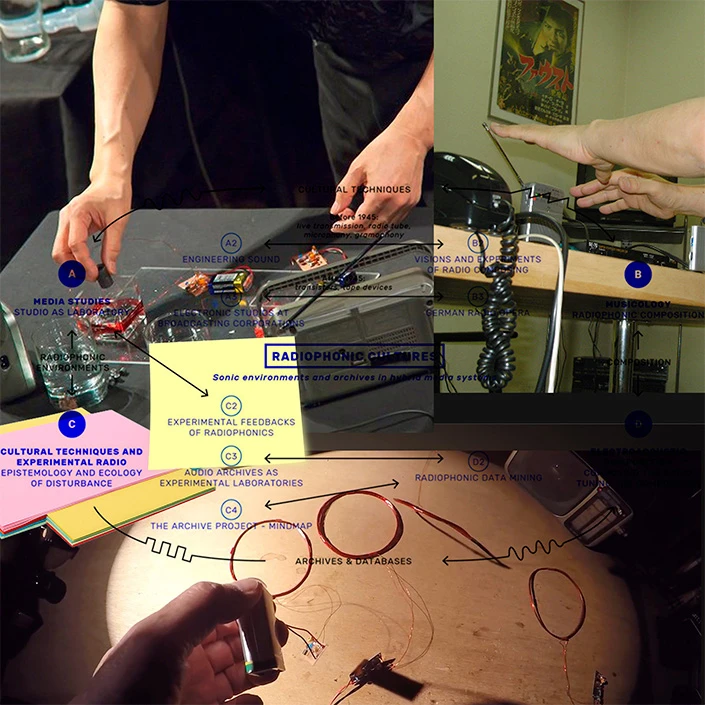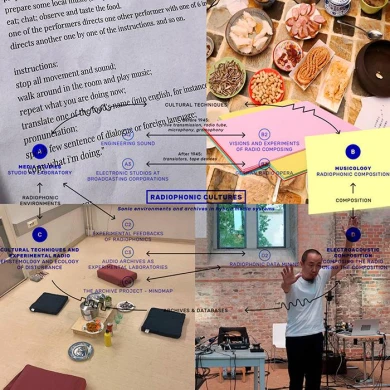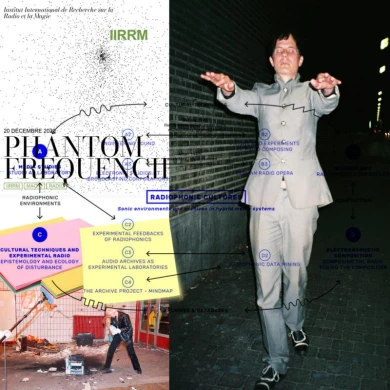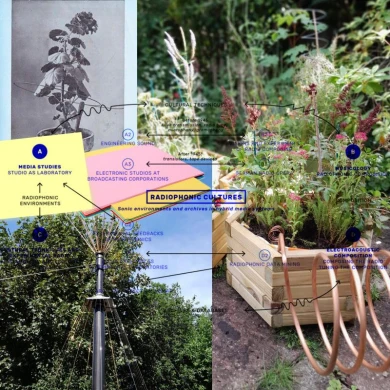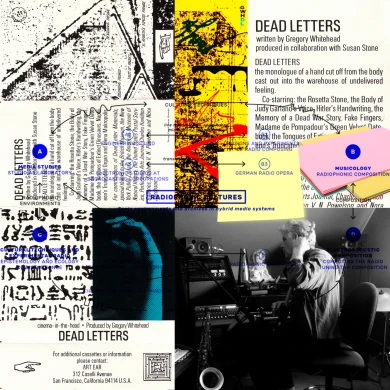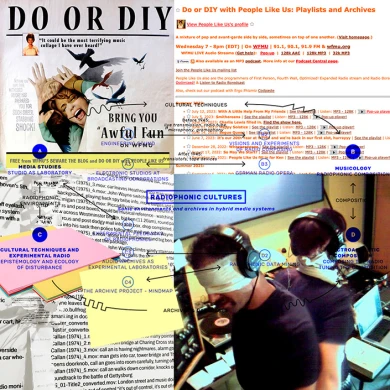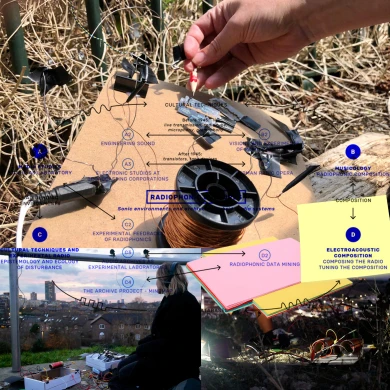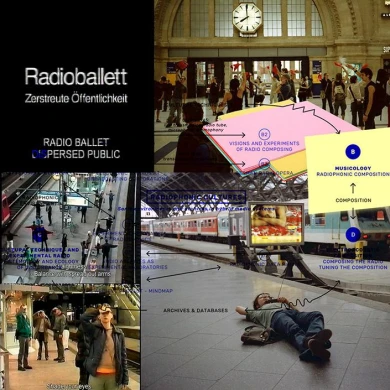Tetsuo Kogawa, what is your notion of radio?
Starting with pirate Ham radio in the 50s and after some interval, I became involved in free radio originating from the Italian Autonomia movements in the 70s. At the time, airwaves were still "carrier" of the signals (generally sounds and images). While I devoted myself to put in the contents that conventional radio never broadcast. I will not repeat the detailed story here, but the important point I learned was that every transmission (commercial, public, and even experimental one) considers the airwaves as "carrier". This means that every radio holds tightly to the same assumption: radio is a tool of sounds or signals. The free radio I involved in was later called Mini FM, but even Mini FM was not different but remained a contents-oriented radio except stressing 'narrow'- casting, not 'broad'- casting. There were hundreds and thousands of free radio and were much freer and more diverse than the conventional ones, but the notion of airwaves-as-carrier remained unchanged.
Already in the 60s when Marshall McLuhan argued that "The medium is the message", he indicated that the form of medium decides the content. But he talked about only the technological difference of media: radio or television. He didn't step inside it. I would say that he overlooked the phenomenology of the airwaves. My first intuition that radio is initially radiation rather than medium became an urgent agenda as the internet radio was more popular and interdependently the remote culture was escalating. Radio had to be redefined by itself. When radio is considered as radiation, radio exists everywhere even if you don't have radio transmitter nor receiver. Radiation exists beyond human beings. Every field and space could be understood from the perspective of electromagnetic field, which is not only monopolized by physics such as Super String Theory but also should be approached by philosophy and arts.
Artificial form of transmission and receiving by the electric circuit is only an explicit way of radiation. Also, radiation is not only for carrying meaningful signals and information from one place to another. Broadcasting and surveilling can work only within the meaningful context. Radioart and sound art might have been balancing with such an artificial distortion and imbalance. Of course, they fail to balance. As radiation is boosted heavier and stronger, the penetration goes deeply. Thus, protecting and shielding becomes in greater scale. Encrypting and decrypting never stops in vain. Radiation never ceases by nature to penetrate into the depth of everything. Is there any adequate level of radiation? What can it decide? Our body should have a key for it. The relationship between our body and electromagnetic radiation is delicate as well as dangerous.
We critically talk about surveillance camera which are now saturated everywhere. But we are less interested in the fact that airwaves are monopolized and regulated by national and international states. Thus, the most basic control of our environment happens in the airwaves. Do you know that long silence in radio broadcasting is prohibited in many countries still today. Airwaves without sounds are prohibited. Radiation is political. Controlling the form of radiation is the most effective in the micropolitics for the state side. In this sense, the internet is a caging logistics which encages airwaves in closed circuit.
What is the phenomenology of the airwaves?
I mentioned "phenomenology of airwaves". I spent quite many years in a boring department of philosophy, but I learned only one thing that phenomenology is not an academic scholarship but a guideline for practice to reveal things "To the Things Themselves". Martin Heidegger rewrote this Husserl's slogan more sharply that phenomenology is "to let what shows itself be seen from itself, just as it shows itself from itself." But they did such a practice in the conceptual level of language. How about the airwaves by phenomenology? Airwaves could provide more cosmic field of our action. Let's throw out the banal knowledge that the "hearing range" of the audiofrequency of human beings is between 20 to 20000 Hz at best. This myth neglects the fact that our perception has numerous layers of "horizons". We always hear multiple harmonics even over 20000 Hz and below 20 Hz. Moreover, we don't hear only by eyers but also by our skins and bones. Our perception always precept over the "vibrating" or oscillating horizons. Audible frequency has its infinite multitude of harmonic resonance toward visual lights and thinkable ideas. So, it is difficult to draw a line between sound art and radioart. Even if you make a single (audible) sound, it makes radio waves by the harmonics too.
Usually, airwaves are considered as imperceptible without the technologically proper receiver. In fact, we approach to the airwaves by radio receiver that converts and modulates them into the audible/visible signals. But we are fully aware of various symptoms deriving from electro-magnetic devices of mind-control, medical equipment, and the "electro-magnetic pollution". Our body doesn't act like nut-and-bolt relationship. It is always horizon-ridden to/with the outer objects. This means that even "direct" perceptible sound can work with some modulation. Direct perception is only a myth.
Given this horizon-ridden function, we can no more cling to the set concept of "receiver" and "sender". Hearing is not only receiving. While hearing, we transmit something toward the sounding objects. In order to perceive, we have to transmit something. Every act of ours has various horizons and we act by stepping across such horizons. Human beings have a certain range of audible, visible, touching and smelling frequencies. Even thinking has a range of horizons of logic and language. If the audible frequency for a typical young person as 20 to 20000Hz and the visible frequency as 430 to 770 THz, what is the frequency spectrum of thinking? I think you could calculate it by the frequency range of neurotransmitters. Presumably, it would be much higher than the visible light.
So, as far as transmission is concerned, at least for me, even sound is not for communicating nor harmonizing but for transmitting-radiating. I bring on the concept of horizon because it can explain that our perception depends on anticipation (referring to Kantian-Husserlian "Antizipation") with the horizons. Just as we don't think that at the far end of the sea horizon, we don't think nothing exists, we always perceive something beyond our perceived. Signals on the eardrum and retina are only the part of the transmission. The point is not whether audible/visible or not but is to reveal various horizons that our "ordinal" perception and preposition hide. So, my radioart operation is to shift such horizons as polymorphously as possible.
What are the implications of his inventions and experiments in relation to broadcasting technologies and their consequent political implications?
My interest in free radio and community radio which were considered as a message�oriented radio was changing when we re-defined our free radio to Mini FM. It neglected the difference of sender/receiver, and the studio became a meeting�performance-workingeven- accommodation. So, it was a natural process that our radio functioned as "therapy" and artistic workshop. In terms of politics, the members of our radio was consisting of the postnew-left generation so that we minded very much how and where we do and preferred "minar" ways. Félix Guattari's notion of "Micro-politics" and "Molecular revolution" reminded us that even in the subtle aspects of how-to�transmit and where-to-transmit and even how to handle microphone politics exist. So our Mini FM initially started with radio with the radical contents but gradually moved to radio without contents.
We believed that this was not a backward from the real and militant politics but were more involved in the deeper level of the reality. As the internet emerged as a popular tool, it pushed our notion that airwaves radio had not to play a role of message deliverer any more. As streaming technology became popular, the internet had an easier advantage to deliver messages than the airwaves radio. For us, keeping the form of airwaves radio became a challenge.
Tetsuo, in your opinion, what is the future of radio after digitalization? What role does it play in contemporary societies? Do you think it is still possible to experiment with the medium itself in the age of the internet?
My question is where we can find our own expression. There are so many tools to do so. But every expression by us might become mere a recyle. Technologically and politicoeconomically, we are close to an end where our body is useless and our idiosyncrasy aka creativity and originality becomes a joke. If we can totally forget our body, it would be the easiest. But we cannot imagine the totally bodyless situation because we are thinking with my body.
I once argued that hands are the last islands of our body. While various automatic system from voice control to telepathic control is increasingly advancing, our hands and fingers had to make the final decision. And hands could remain the last island of tacky redundancy and contingency of our body. A series of my "hand-weaving" method of radioart derived from this concept. In the quite near future, even our hands and fingers will become useless after the peak of the ciphering and decoding battle.
As long as it doesn't happen yet, we can have a strategy to such a situation. There is a still meaningful technique of phenomenology called "bracketing". It's not a pretentious ignorance but the more positive activity to artificially intensify the ongoing tendency. Let's try to intensify the bodylessness and "recursion". Simplisticly, we try to become an android by bracketing our already becoming-cyborg body and to act as an android not pretending it.
When it happens, however, it will not be the end of our body but the beginning of our new body, more microscopic body. Now that I argue this, I will not use my voice but should use a text-to-speech. It might reveal that Tetsuo Kogawa doesn't exist as a body entity. You have to do the phenomenological bracketing by yourself too.
Note: The artificial voice used is a gender-neutral voice based on the prototipo Q.
